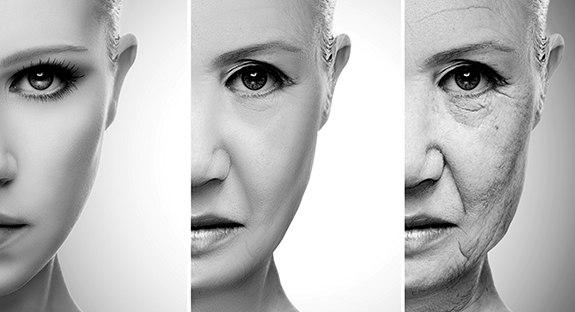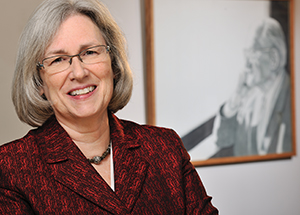Anne B. Newman’s Research Deciphers the Mysteries of Aging, Longevity
Most days during the week, a Pitt physicist arrives to work at his office on the second floor of Allen Hall. In recent years, he has been engaged in the difficult challenges posed by the principles of quantum mechanics. Routinely, he sits at his desk, tapping away at his big-screen Apple computer. He consults his colleagues, he writes papers, he ponders new realities. The physicist, Ed Gerjuoy, is 95 years old.
days during the week, a Pitt physicist arrives to work at his office on the second floor of Allen Hall. In recent years, he has been engaged in the difficult challenges posed by the principles of quantum mechanics. Routinely, he sits at his desk, tapping away at his big-screen Apple computer. He consults his colleagues, he writes papers, he ponders new realities. The physicist, Ed Gerjuoy, is 95 years old.
“I want to keep working as long as I can,” he says. “What’s most important to me is to spend my time usefully, stay healthy, and retain a reasonable degree of contact with my colleagues.”
In a TED talk he presented last year, Gerjuoy—a professor emeritus of physics and astronomy—attributes his healthy longevity to “pure good luck,” but he’s also done many things during his life to optimize that luck. He has never smoked. He last drank alcohol in 1946, after a bout with hepatitis. He prefers the stairs to the elevator. He continues to monitor his health with routine visits to his doctor. And he has remained engaged in life: In addition to his successful, ongoing career as a physicist, Gerjuoy earned a law degree at age 59 and took an early-retirement hiatus from his Pitt career to become an environmental law consultant at age 64. During this time, he remained involved in “activities consistent with my various deep beliefs and values,” such as the American Civil Liberties Union and GASP, the Group Against Smog and Pollution. When he returned full time to physics in 2003, at age 85, he ventured into a new field of study in quantum mechanics.
“As long as I can, I intend to continue pretending that I’m not aging, even though I know I am,” he says in the TED talk. “The idea of maintaining life is built into our genes.” Yet, some people manage better than others. Why?
In the United States, fewer than two people in 10,000 reach age 100. The so-called super-centenarians, age 110 and older, account for just .6 percent of all American centenarians, or about one in seven million of the total U.S. population. That leaves the rest of us wondering: How do these exceptional elders, like Ed Gerjuoy, achieve such a long and healthy life?
A University of Pittsburgh physician—epidemiologist Anne B. Newman—has found some answers, and she’s looking for more. As director of the University’s Center for Aging and Population Health in the Graduate School of Public Health (GSPH), she is at the forefront of research on factors that contribute to optimal longevity.
University of Pittsburgh physician—epidemiologist Anne B. Newman—has found some answers, and she’s looking for more. As director of the University’s Center for Aging and Population Health in the Graduate School of Public Health (GSPH), she is at the forefront of research on factors that contribute to optimal longevity.
“As a physician, I have taken care of many frail old people with health issues such as end-stage heart failure, dementia, arthritis, and loss of vision and hearing,” says Newman, professor and chair in the Department of Epidemiology. “There is no question that old age can be a very tough time of life, but I really believe that we can forestall many of these problems and improve the quality of life for many older people.”
Newman’s center at Pitt explores the puzzle of optimizing life span and limiting the disabling effects of age-related chronic disease. Her own research is in the epidemiology of longevity, a relatively new discipline searching for a deeper understanding of the underlying biologic pathways that control the human life span.
“The rates of survival to advanced old age have increased dramatically over the past century,” notes Newman. In the United States in 1900, there were about 100,000 people age 85 and older; in 2010, there were 5.5 million. Newman attributes this, in large part, to environmental factors such as improvements in public housing, nutrition, education, living conditions, and medical treatments, which have reduced premature deaths, especially infant mortality. But other factors are in play, as well. Recent census data indicate that those age 90 and above, especially the subgroup of those 100 and older, are the group that’s increasing fastest among those 65 and older. For those born in the year 2000, 13 percent of men and 24 percent of women are projected to reach age 90.
Some say we’re experiencing a longevity epidemic. Pitt’s Center for Aging and Population Health (CAPH), within the Department of Epidemiology, is perfectly positioned to address this “epidemic” with the antidote of healthy aging.
“I think we can learn more about old age by studying the people who do well rather than focusing on the people who don’t,” says Newman. Her bottom-line goal is to make old age better.
CAPH is one of 32 comprehensive prevention research center programs supported by the nation’s Centers for Disease Control and Prevention and by research and training grants from the National Institutes of Health. Combining community knowledge with the expertise of academics and public health organizations, these centers conduct research and develop programs to create practical solutions and strategies for promoting healthier communities.
The Pittsburgh center is one of only two such centers nationally focusing on older adults. Its work includes several large research studies of aging.
In a 2012 survey of longevity research—including longevity data from the Framingham Heart Study and Pitt’s own Cardiovascular Health Study— Newman and coauthor Joanne Murabito, an associate professor of medicine at Boston University, found that, for people at midlife, the risk factors for a shorter lifespan include smoking, higher levels of blood pressure and total cholesterol, and glucose intolerance. But they also reported that, according to worldwide findings, these cardiovascular risk factors are only one aspect of a far more complex puzzle.
Since 2004, Pitt’s Center for Aging and Population Health has been a partner in the national Long Life Family Study (LLFS), which looks for genetic variants that may protect healthy aging and/or prolong life. The research program—funded by the National Institute on Aging and involving the work of four partner institutions nationwide—conducts research to uncover factors that contribute to optimal longevity and to decipher why some people are able to dodge disabilities and chronic diseases as they age. Newman is a principal investigator on the study’s Pittsburgh segment.
Essentially, the project asks: What are the secrets of a long and healthy life? Based on research to date, there are likely many factors—probably intermingling—that influence healthy aging. For starters, scientists know that about 25 percent of longevity is inherited. Siblings of centenarians have a significantly greater likelihood of surpassing the age of 90, and the onset of chronic problems such as coronary heart disease, hypertension, diabetes, and stroke is delayed in the offspring of centenarians.
Identifying genes that promote healthy aging and long life is a key LLFS goal. One gene of interest is associated with apolipoprotein E or APOE, which plays a role in fat metabolism and cholesterol in the blood. The gene appears in slightly different forms, and the differences are associated with variations in life span. Because of its potential to shed light on longevity, APOE has been the focus of multiple studies in various populations worldwide.
Further findings from LLFS highlight the role of other factors, such as elevated Hemoglobin A1C, a characteristic of insulin resistance and a predictor of heightened aging processes.
Telomeres, too, seem to play a role in life span. Telomeres are repetitive DNA sequences at the end of chromosomes. They preserve important genetic information by preventing chromosomes from unraveling. Telomeres typically become shorter as we age, and they appear to be a marker for the aging of cells. But some older people retain longer telomeres. LLFS researchers are exploring what that may mean for biological aging.
It’s clear that genes and biogenic components play a role in longevity and that heredity influences healthy aging. But research also shows that nutrition, eating habits, lifestyle behaviors (including regular exercise), and even some surprising aspects—like socioeconomic status, level of educational attainment, and place of residence—have an effect, too. In fact, these factors account for the other 75 percent chance-of-influence on longevity, beyond heredity, meaning longevity can be influenced.
From the start of her career, Newman (A&S ’78, MED ’82, GSPH ’87) has been involved in seminal aging research, ranging from the assessment of cardiovascular risk factors to the effects of aging and mobility impairment on body composition, to various population studies of disease and disability in older adults. Today, in addition to other research and training activities, she is the principal investigator on several long-term studies and clinical trials, funded by the National Institute on Aging, which are designed to prevent disability in older adults.
“Our research,” says Newman, “focuses on getting more people to live well rather than to simply live longer. People who live a long time show us what I believe is the true human potential for healthy aging. So it is not longevity per se that interests me but that the pathway to longevity can help us understand the pathway to health and function in old age.”
In particular, at Pitt’s Center for Aging and Population Health, Newman leads efforts to encourage older adults to monitor their health by staying engaged with the medical system, especially while still relatively healthy. Physicist Ed Gerjuoy is among those who have participated.
Newman emphasizes that, often, she sees individuals with the onset of health problems who simply have the attitude, ‘Well, I’m getting older, so some changes are expected. I’ll take care of this new symptom later ... tomorrow ... next month ... next year. ’ Instead, says Newman, the focus should be on preserving health at any age. “Our goal is to improve the aging process to improve function. We know there is potential to increase the maximal life expectancy, but we must first try to decrease the period of life that is disabled in old age.”
One primary result of the center’s research and collaboration with other experts has been the development of the 10 Keys™ to Healthy Aging, which are the 10 most important factors that contribute to optimal aging (http://www.caph.pitt.edu/). They are: lower systolic blood pressure; stop smoking; participate in cancer screening; get immunized regularly; regulate blood glucose; lower LDL cholesterol; be physically active; maintain healthy bones, joints, and muscles; maintain social contact; and combat depression.
Newman and her colleagues haven’t yet found all of the answers to the intriguing puzzle of healthy longevity, but they haven’t stopped searching, either. “It’s interesting to try to see just what is the human potential for aging well,” Newman says.
This story is excerpted from the Winter 2014 issue of Pitt Magazine.
Other Stories From This Issue
On the Freedom Road

Follow a group of Pitt students on the Returning to the Roots of Civil Rights bus tour, a nine-day, 2,300-mile journey crisscrossing five states.
Day 1: The Awakening
Day 2: Deep Impressions
Day 3: Music, Montgomery, and More
Day 4: Looking Back, Looking Forward
Day 5: Learning to Remember
Day 6: The Mountaintop
Day 7: Slavery and Beyond
Day 8: Lessons to Bring Home
Day 9: Final Lessons

